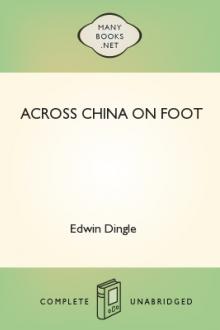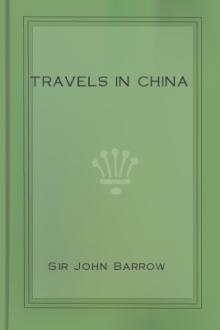Across China on Foot, Edwin John Dingle [ebook pc reader TXT] 📗

- Author: Edwin John Dingle
- Performer: -
Book online «Across China on Foot, Edwin John Dingle [ebook pc reader TXT] 📗». Author Edwin John Dingle
"A fever called No-ma-dzï works great havoc among the Nou-su every year, and the people are very much afraid of it. No person will stay by the sick-bed to nurse the unfortunate victim. Instead, food and water are placed by his bedside and, covered with his quilt, he is left at the mercy of the disease. Since as the fever progresses the patient will perspire, heavy stones are placed on the quilt, that it may not be thrown off, and the sick person take cold. Many an unfortunate sufferer has through this strange practice died from suffocation. After a time the relatives will return to see what course the disease has taken. This fever seems to yield to quinine, for Mr. John Li has seen several persons recover to whom he had administered this drug. When a man dies, his relatives, as soon as they receive the news, hold in their several homes a feast of mourning called by them the Za. A pig or sheep is sacrificed at the doorway, and it is supposed that intercourse is thus maintained between the living persons and the late departed spirit. The near kindred, on hearing of the death of a relative, take a fowl and strangle it; the shedding of its blood is not permissible. This fowl is cleaned and skewered, and the mourner then proceeds to the house where the deceased person is lying, and sticks this fowl at the head of the corpse as an offering. The more distant relatives do not perform this rite, but each leads a sheep to the house of mourning, and the son of the deceased man strikes each animal three times with a white wand, while the Peh-mo (priest or magician) stands by, and announcing the sacrifice by calling 'so and so,' giving of course the name, presents the soft woolly offering.
"Formerly the Nou-su burned their dead. Said a Nou-su youth to me years ago, 'The thought of our friends' bodies either turning to corruption or being eaten by wild beasts is distasteful to us, and therefore we burn our dead.' The corpse is burnt with wood, and during the cremation the mourners arrange themselves around the fire and chant and dance. The ashes are buried, and the ground leveled. This custom is still adhered to among the Nou-su of the independent Lolo territory or more correctly Papu country of Western Szech'wan. The tribesmen who dwell in the neighborhood of Weining and Chao-t'ong have adopted burial as the means of disposing of their dead, adding some customs peculiar to themselves.
"On the day of the funeral the horse which the deceased man was in the habit of riding is brought to the door and saddled by the Pehmo. The command is then given to lead the horse to the grave. All the mourners follow, and marching or dancing in intertwining circles, cross and recross the path of the led horse until the poor creature, grown frantic with fear, rushes and kicks in wild endeavor to escape from the confusion. The whole company then raise a great shout and call, 'The soul has come to ride the horse, the soul has come to ride the horse.' A contest then follows among the women of the deceased man's household for the possession of this horse, which is henceforth regarded as of extreme value. It is difficult to discover much about the religion of the Nou-su, because so many of their ancient customs have fallen into disuse during the intercourse of the people with the Chinese. At the ingathering of the buckwheat, when the crop is stacked on the threshing floor, and the work of threshing is about to begin, the simple formula, 'Thank you, Ilsomo,' is used. Ilsomo seems to be a spirit who has control over the crops; whether good or evil, it is not easy to determine. Ilsomo is not God, for at present, when the Nou-su wish to speak of God, they use the word Soe, which means Master.
"In the independent territory of the Nou-su, to the west of Szech'wan, the term used for God is Eh-nia, and a Nou-su who has much intercourse with the independent people contends that there are three names indicative of God, each representing different functions if not persons of the Godhead. These names are: Eh-nia, Keh-neh, Um-p'a-ma. The Nou-su believe in ancestor worship, and perhaps the most interesting feature of their religion is the peculiar form this worship takes. Instead of an ancestral tablet such as the Chinese use, the Nou-su worship a small basket (lolo) about as large as a duck's egg and made of split bamboo. This 'lolo' contains small bamboo tubes an inch or two long, and as thick as an ordinary Chinese pen handle. In these tubes are fastened a piece of grass and a piece of sheep's wool. A man and his wife would be represented by two tubes, and if he had two wives, an extra tube would be placed in the 'lolo.' At the ceremony of consecration the Pehmo attends, and a slave is set apart for the purpose of attending to all the rites connected with the worship of the deceased person. The 'lolo' is sometimes placed in the house, but more often on a tree in the neighborhood or it may be hidden in a rock. For persons who are short-lived, the ancestral 'lolo' is placed in a crevice in the wall of some forsaken and ruined building. Every three years the 'lolo' is changed, and the old one burnt. The term 'lolo,' by which the Nou-su are generally known, is a contemptuous nickname given them by the Chinese in reference to this peculiar method of venerating their ancestors.
"Hill worship is another important feature of Nou-su religious life. Most important houses are built at the foot of a hill and sacrifice is regularly offered on the hill-side in the fourth month of each year. The Pehmo determines which is the most propitious day, and the Tumuh and his people proceed to the appointed spot. A limestone rock with an old tree trunk near is chosen as an altar, and a sheep and pig are brought forward by the Tumuh. The Pehmo, having adjusted his clothes, sits cross-legged before the altar, and begins intoning his incantations in a low muttering voice. The sacrifice is then slain, and the blood poured beneath the altar, and a handful of rice and a lump of salt are placed beneath the stone. Some person then gathers a bundle of green grass, and the Pehmo, having finished intoning, the altar is covered, and all return to the house. The Pehmo then twists the grass into a length of rope, which he hangs over the doorway of the house. Out of a piece of willow a small arrow is made, and a bow similar in size is cut out of a peach tree. These are placed on the doorposts. On a piece of soft white wood a figure of a man is roughly carved, and this, with two sticks of any soft wood placed cross-wise, is fastened to the rope hanging over the doorway, on each side of which two small sticks are placed. The Pehmo then proceeds with his incantation, muttering: 'From now, henceforth and for ever will the evil spirits keep away from this house.'
"Most Nou-su at the present time observe the New Year festival on the same date and with the same customs as the Chinese. Formerly this was not so, and even now in the remoter districts New Year's day is observed on the first day of the tenth month of the Chinese year. A pig and sheep are killed and cleaned, and hung in the house for three days. They are then taken down, cut up and cooked. The family sit on buckwheat straw in the middle of the chief room of the house. The head of the house invites the others to drink wine, and the feasting begins. Presently one will start singing, and all join in this song: 'How firm is this house of mine. Throughout the year its hearth fire has not ceased to burn, My food corn is abundant, I have silver and also cash, My cattle have increased to herds, My horses and mules have all white foreheads K'o K'o Ha Ha Ha Ha K'o K'o, My sons are filial, My wife is virtuous, In the midst of flesh and wine we sleep, Our happiness reaches unto heaven, Truly glorious is this glad New Year.' A scene of wild indulgence then frequently follows.
"The Nou-su possess a written language. Their books were originally made of sheepskin, but paper is now used. The art of printing was unknown, and many books are said to have been lost. The books are illustrated, but the drawings are extremely crude."[T]
FOOTNOTES:
[R]
Yün-nan, The Link between India, and the Yangtze, by Major H.R. Davies, Cambridge University Press.
[S]
Literally "Eyes of the Earth"—the landlords.
[T]
A good deal of information in this chapter was obtained from an article by the Rev. C E Hicks, published in the Chinese Recorder for March, 1910. The portion quoted is taken bodily from this excellent article.
FIFTH JOURNEY. CHAO-T'ONG-FU TO TONG-CH'UAN-FU.
Revolting sights compensated for by scenery. Most eventful day in the trip. Buying a pony, and the reason for its purchase. Author's pony kicks him and breaks his arm. Chastising the animal, and narrow escape from death. Rider and pony a sorry sight. An uneasy night. Reappearance of malaria. Author nearly forced to give in. Heavy rain on a difficult road. At Ta-shui-tsing. Chasing frightened pony in the dead of night. Bad accommodation. Lepers and leprosy. Mining. At Kiang-ti. Two mandarins, and an amusing episode. Laying foundation of a long illness. The Kiang-ti Suspension Bridge. Hard climbing. Tiffin in the mountains. Sudden ascents and descents. Description of the country. Tame birds and what they do. A non-enterprising community. Pleasant travelling without perils. Majesty of the mountains of Yün-nan.
Whilst in this district, as will have been seen, one has to steel himself to face some of the most revolting sights it is possible to imagine, he is rewarded by the grandeur of the scenic pictures which mark the downward journey to Tong-ch'uan-fu.
The stages to Tong-ch'uan-fu were as follows:—
Length of stage Height above sea level 1st day T'ao-üen 70 li. —— ft. 2nd day Ta-shui-tsing 30 li. 9,300 ft. 3rd day Kiang-ti 40 li. 4,400 ft. 4th day Yi-che-shïn 70 li. 6,300 ft. 5th day Hong-shïh-ai 90 li. 6,800 ft. 6th day Tong-ch'uan-fu 60 li. 7,250 ft.The Chao-t'ong plateau, magnificently level, runs out past the picturesquely-situated tower of Wang-hai-leo, from which one overlooks a stretch of water. A memorial arch, erected by the Li family of Chao-t'ong-fu, graces the main road farther on, and is probably one of the best of its kind in Yün-nan, comparing favorably with the best to be found in Szech'wan, where monumental architecture abounds. Perhaps the only building of interest in Chao-t'ong is the ancestral hall of the wealthy family mentioned above, the carving of which is magnificent.
At the end of the first day we camped at the Mohammedan village of T'ao-üen, literally "Peach Garden," but the peach trees might once have been, though now certainly they are not.
It was cold when we left, 38° F., hard frost. All the world seemed buttoned up and great-coated; the trees seemed wiry and cheerless; the legs of the pack-horses seemed brittle, and I felt so. Breath issued visibly from the mouth as I trudged along. My boy and I nearly came to blows in the early morning. I wanted to lie on; he did





Comments (0)